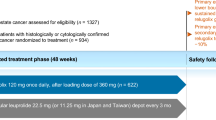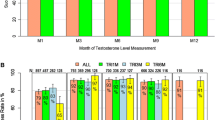Abstract
Triptorelin [available in 1-, 3- and 6-month intramuscular sustained-release (SR) formulations] is a gonadotropin-releasing hormone (GnRH) agonist that effectively achieves and maintains castrate serum testosterone levels and is generally well tolerated in men with locally advanced or metastatic prostate cancer. The availability of the triptorelin 3- and 6-month SR formulations allows flexibility of treatment schedules for the patient and physician. The triptorelin 6-month SR formulation may improve convenience and patient’s potential adherence, health-related quality of life and resource use relative to GnRH agonists that require more frequent administration. This review provides a summary of the clinical evidence regarding the use of the 3- and 6-month SR formulations of triptorelin in the treatment of locally advanced and metastatic prostate cancer in the EU.
Similar content being viewed by others
References
Ferlay J, Steliarova-Foucher E, Lortet-Tieulent J, et al. Cancer incidence and mortality patterns in Europe: estimates for 40 countries in 2012. Eur J Cancer. 2013;49(6):1374–403.
Siegel RL, Miller KD, Jemal A. Cancer statistics, 2017. CA Cancer J Clin. 2017;67(1):7–30.
Breul J, Lundström E, Purcea D, et al. Efficacy of testosterone suppression with sustained-release triptorelin in advanced prostate cancer. Adv Ther. 2017;34(2):513–23.
Cornford P, Bellmunt J, Bolla M, et al. EAU-ESTRO-SIOG guidelines on prostate cancer. Part II: treatment of relapsing, metastatic, and castration-resistant prostate cancer. Eur Urol. 2017;71(4):630–42.
Crawford ED, Phillips JM. Six-month gonadotropin releasing hormone (GnRH) agonist depots provide efficacy, safety, convenience, and comfort. Cancer Manag Res. 2011;3(1):201–9.
Merseburger AS, Hupe MC. An update on triptorelin: current thinking on androgen deprivation therapy for prostate cancer. Adv Ther. 2016;33(7):1072–93.
Decapeptyl SR 3 mg. UK summary of product characteristics. Surrey: Electronic Medicines Compendium. 2017.
Decapeptyl SR 11.25 mg. UK summary of product characteristics. Surrey: Electronic Medicines Compendium. 2016.
Decapeptyl SR 22.5mg. UK summary of product characteristics. Surrey: Electronic Medicines Compendium. 2016.
Keating GM. Triptorelin embonate (6-month formulation). Drugs. 2010;70(3):347–53.
Lundström EA, Rencken RK, van Wyk JH, et al. Triptorelin 6-month formulation in the management of patients with locally advanced and metastatic prostate cancer: an open-label, non-comparative, multicentre, phase III study. Clin Drug Investig. 2009;29(12):757–65.
Teillac P, Heyns CF, Kaisary AV, et al. Pharmacodynamic equivalence of a decapeptyl 3-month SR formulation with the 28-day SR formulation in patients with advanced prostate cancer. Horm Res. 2004;62(5):252–8.
Martinez-Pineiro L, Schalken JA, Cabri P, et al. Evaluation of urinary prostate cancer antigen-3 (PCA3) and TMPRSS2-ERG score changes when starting androgen-deprivation therapy with triptorelin 6-month formulation in patients with locally advanced and metastatic prostate cancer. BJU Int. 2014;114(4):608–16.
de la Taille A, Martinez-Pineiro L, Cabri P, et al. Factors predicting progression to castrate-resistant prostate cancer in patients with advanced prostate cancer receiving long-term androgen-deprivation therapy. BJU Int. 2017;119(1):74–81.
Østergren PB, Kistorp C, Fode M, et al. Luteinizing hormone-releasing hormone agonists are superior to subcapsular orchiectomy in lowering testosterone levels of men with prostate cancer: results from a randomized clinical trial. J Urol. 2017;197(6):1441–7.
Bolla M, De Reijke TM, Van Tienhoven G, et al. Duration of androgen suppression in the treatment of prostate cancer. N Engl J Med. 2009;360(24):2516–27.
Botto H, Roupret M, Mathiew F, et al. Multicentre randomized trial comparing triptorelin medical castration versus surgical castration in the treatment of locally advanced or metastatic prostate cancer [in French]. Prog Urol. 2007;17(2):235.9.
Shore ND, Sieber P, Schimke L, et al. Comparison of tolerability and adverse events following treatment with two GnRH agonists in patients with advanced prostate cancer. Urol Nurs. 2013;33(5):236–48.
Lebret T, Davin J-L, Hennequin C, et al. Selection criteria for initiation and renewal of luteinizing hormone-releasing hormone agonist therapy in patients with prostate cancer: a French prospective observational study. Ther Adv Urol. 2014;6(6):205–14.
Schulman C. Assessing the attitudes to prostate cancer treatment amoung European male patients. BJU Int. 2007;100(Suppl 1):6–11.
Eisenhardt A, Schneider T, Scheithe K, et al. Quality of life of patients with prostate cancer under androgen deprivation with GnRH analogues: results of the noninterventional study TRIPTOSIX [in German]. Urologe A. 2016;55(2):176–83.
Cornford P, Jefferson K, Cole O, et al. Switching to a 6-monthly triptorelin formulation for prostate cancer (Pca) reduces patient-NHS interactions and hospital resource use: real world evidence (Rwe) from project deserve (decapeptyl service evaluation) [abstract]. Value Health. 2015;18:A483.
Acknowledgements
The manuscript was reviewed by: A.V. Kaisary, Consultant Urological Surgeon, Kaisary Medical Limited, London, UK; F. Mutlu Icduygu, Department of Medical Genetics, Giresun University, Giresun, Turkey; G. Niegisch, Department of Urology, Heinrich-Heine University, Düsseldorf, Germany; I. Nikolic, Faculty of Medical Sciences, University of Kragujevac, Kragujevac, Serbia; K. Undela, Department of Pharmacy Practice, JSS College of Pharmacy, Jagadguru Sri Shivarathreeshwara University, Mysuru, India. During the peer review process, the marketing authorization holder of triptorelin was also offered an opportunity to review this article. Changes resulting from comments received were made on the basis of scientific and editorial merit.
Author information
Authors and Affiliations
Corresponding author
Ethics declarations
Funding
The preparation of this review was not supported by any external funding.
Conflict of interest
K. McKeage and K.A. Lyseng-Williamson are employees of Adis-Springer, are responsible for the article content and declare no conflicts of interest. Additional information about this Adis Drug Q&A can be found at http://www.medengine.com/Redeem/CE48F060622B0B0F.
Rights and permissions
About this article
Cite this article
McKeage, K., Lyseng-Williamson, K.A. Triptorelin 3- and 6-month sustained-release formulations in locally advanced or metastatic prostate cancer: a profile of their use in the EU. Drugs Ther Perspect 33, 321–325 (2017). https://doi.org/10.1007/s40267-017-0413-y
Published:
Issue Date:
DOI: https://doi.org/10.1007/s40267-017-0413-y




